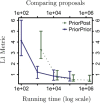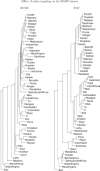Phylogenetic inference via sequential Monte Carlo
- PMID: 22223445
- PMCID: PMC3376373
- DOI: 10.1093/sysbio/syr131
Phylogenetic inference via sequential Monte Carlo
Abstract
Bayesian inference provides an appealing general framework for phylogenetic analysis, able to incorporate a wide variety of modeling assumptions and to provide a coherent treatment of uncertainty. Existing computational approaches to bayesian inference based on Markov chain Monte Carlo (MCMC) have not, however, kept pace with the scale of the data analysis problems in phylogenetics, and this has hindered the adoption of bayesian methods. In this paper, we present an alternative to MCMC based on Sequential Monte Carlo (SMC). We develop an extension of classical SMC based on partially ordered sets and show how to apply this framework--which we refer to as PosetSMC--to phylogenetic analysis. We provide a theoretical treatment of PosetSMC and also present experimental evaluation of PosetSMC on both synthetic and real data. The empirical results demonstrate that PosetSMC is a very promising alternative to MCMC, providing up to two orders of magnitude faster convergence. We discuss other factors favorable to the adoption of PosetSMC in phylogenetics, including its ability to estimate marginal likelihoods, its ready implementability on parallel and distributed computing platforms, and the possibility of combining with MCMC in hybrid MCMC-SMC schemes. Software for PosetSMC is available at http://www.stat.ubc.ca/ bouchard/PosetSMC.
Figures












Similar articles
-
An Annealed Sequential Monte Carlo Method for Bayesian Phylogenetics.Syst Biol. 2020 Jan 1;69(1):155-183. doi: 10.1093/sysbio/syz028. Syst Biol. 2020. PMID: 31173141
-
Online tree expansion could help solve the problem of scalability in Bayesian phylogenetics.Syst Biol. 2023 Nov 1;72(5):1199-1206. doi: 10.1093/sysbio/syad045. Syst Biol. 2023. PMID: 37498209 Free PMC article.
-
Posterior Summarization in Bayesian Phylogenetics Using Tracer 1.7.Syst Biol. 2018 Sep 1;67(5):901-904. doi: 10.1093/sysbio/syy032. Syst Biol. 2018. PMID: 29718447 Free PMC article.
-
A biologist's guide to Bayesian phylogenetic analysis.Nat Ecol Evol. 2017 Oct;1(10):1446-1454. doi: 10.1038/s41559-017-0280-x. Epub 2017 Sep 21. Nat Ecol Evol. 2017. PMID: 28983516 Free PMC article. Review.
-
Scalable Bayesian phylogenetics.Philos Trans R Soc Lond B Biol Sci. 2022 Oct 10;377(1861):20210242. doi: 10.1098/rstb.2021.0242. Epub 2022 Aug 22. Philos Trans R Soc Lond B Biol Sci. 2022. PMID: 35989603 Free PMC article. Review.
Cited by
-
Online Bayesian Phylodynamic Inference in BEAST with Application to Epidemic Reconstruction.Mol Biol Evol. 2020 Jun 1;37(6):1832-1842. doi: 10.1093/molbev/msaa047. Mol Biol Evol. 2020. PMID: 32101295 Free PMC article.
-
An improved approximate-Bayesian model-choice method for estimating shared evolutionary history.BMC Evol Biol. 2014 Jul 3;14:150. doi: 10.1186/1471-2148-14-150. BMC Evol Biol. 2014. PMID: 24992937 Free PMC article.
-
Accelerating Bayesian inference for evolutionary biology models.Bioinformatics. 2017 Mar 1;33(5):669-676. doi: 10.1093/bioinformatics/btw712. Bioinformatics. 2017. PMID: 28025203 Free PMC article.
-
Evolutionary inference via the Poisson Indel Process.Proc Natl Acad Sci U S A. 2013 Jan 22;110(4):1160-6. doi: 10.1073/pnas.1220450110. Epub 2012 Dec 28. Proc Natl Acad Sci U S A. 2013. PMID: 23275296 Free PMC article.
-
Effective Online Bayesian Phylogenetics via Sequential Monte Carlo with Guided Proposals.Syst Biol. 2018 May 1;67(3):490-502. doi: 10.1093/sysbio/syx090. Syst Biol. 2018. PMID: 29186587 Free PMC article.
References
-
- Altekar G, Dwarkadas S, Huelsenbeck JP, Ronquist F. Parallel Metropolis coupled Markov chain Monte carlo for Bayesian phylogenetic inference. Bioinformatics. 2004;20:407–415. - PubMed
-
- Andrieu C, Doucet A, Holenstein R. Particle Markov chain Monte Carlo methods. J. R. Stat. Soc. Series B. Stat. Methodol. 2010;72:269–342.
-
- Bourque M. Arbres de Steiner et réseaux dont certains sommets sont à localisation variable [PhD dissertation]. Montreal (QC): Université de Montréal. 1978
-
- Cannone JJ, Subramanian S, Schnare MN, Collett JR, D'Souza LM, Du Y, Feng B, Lin N, Madabusi LV, Muller KM, Pande N, Shang Z, Yu N, Gutell RR. The comparative RNA web (CRW) site: an online database of comparative sequence and structure information for ribosomal, intron, and other RNAs. BMC Bioinformatics. 2002;3:2. - PMC - PubMed

